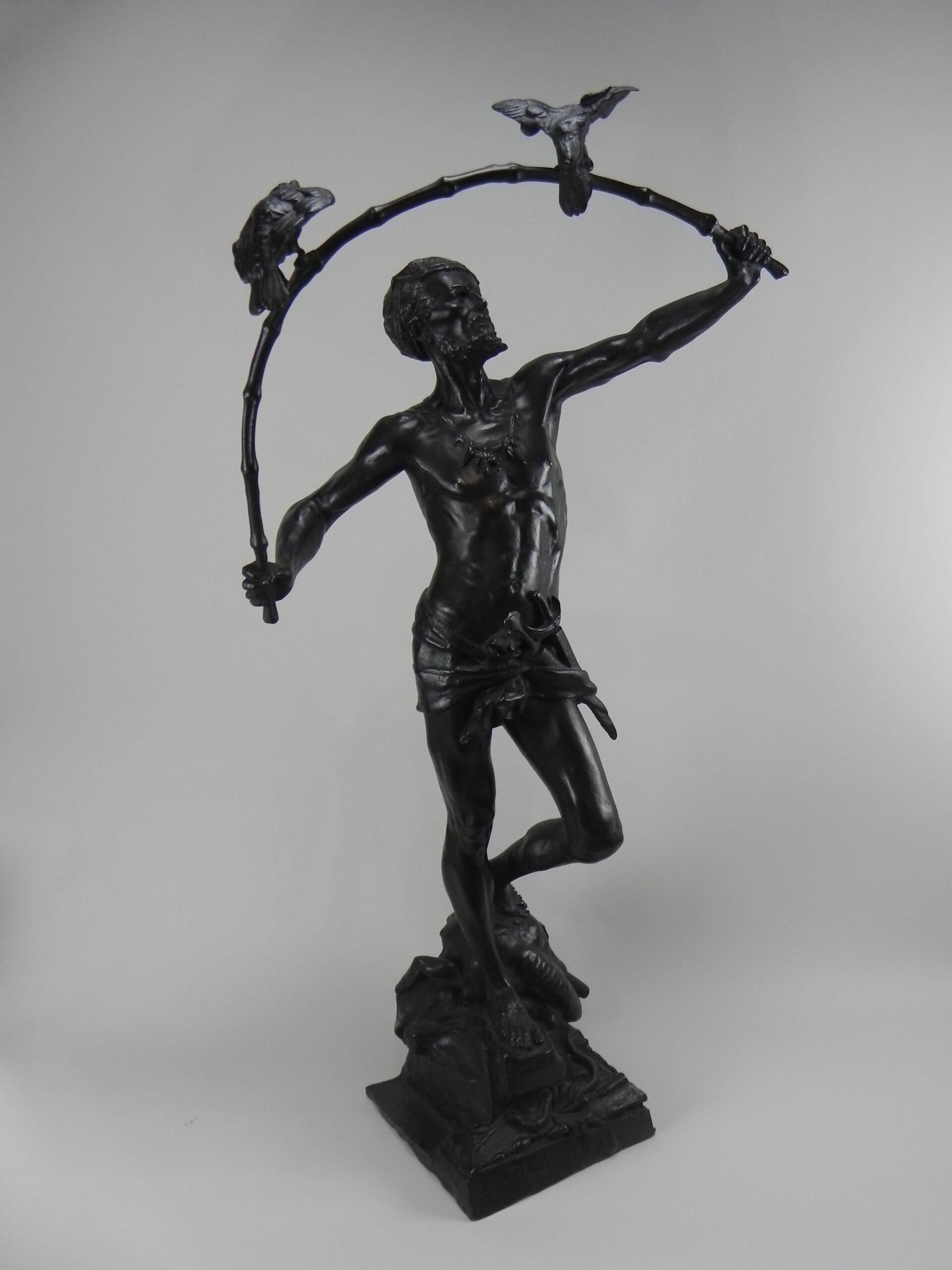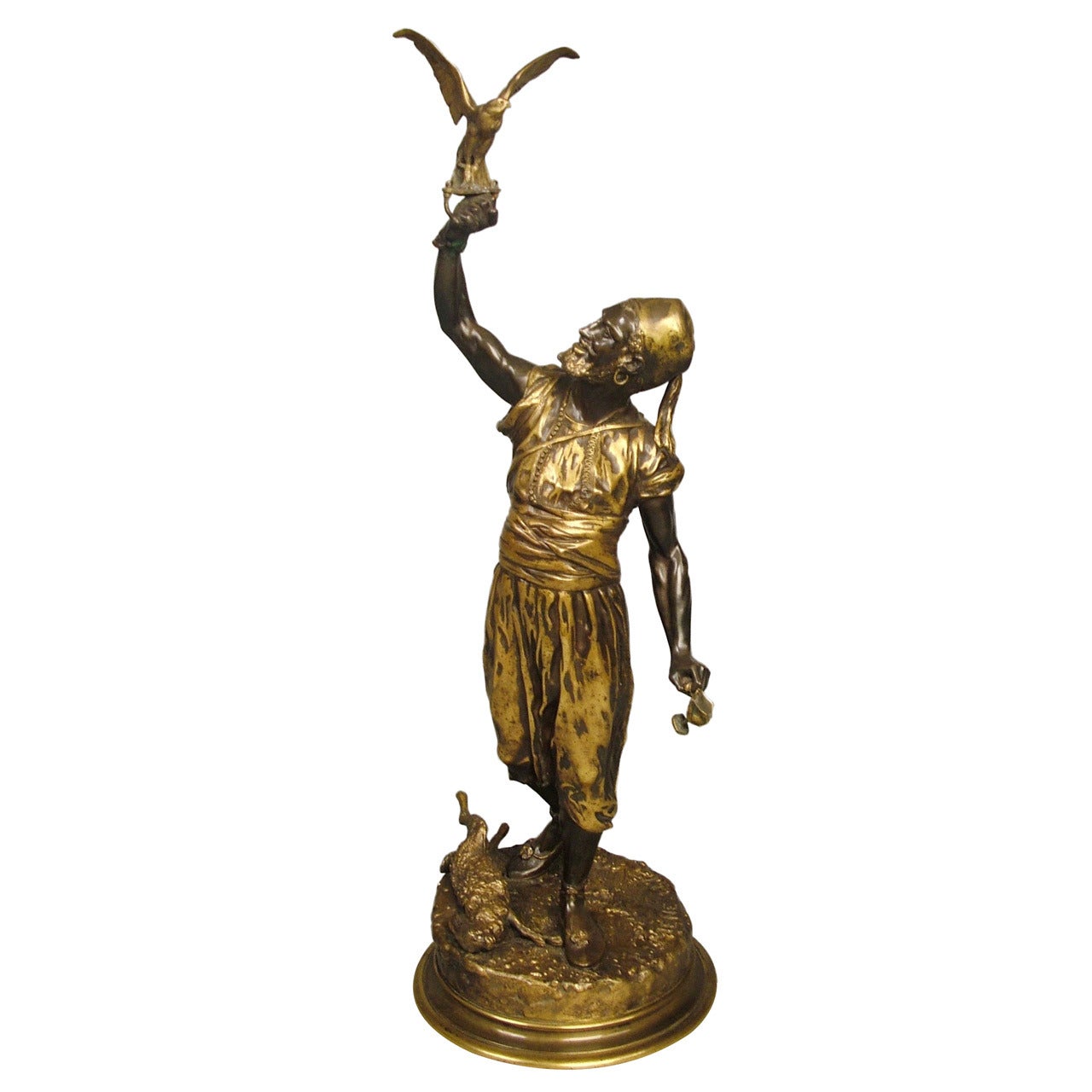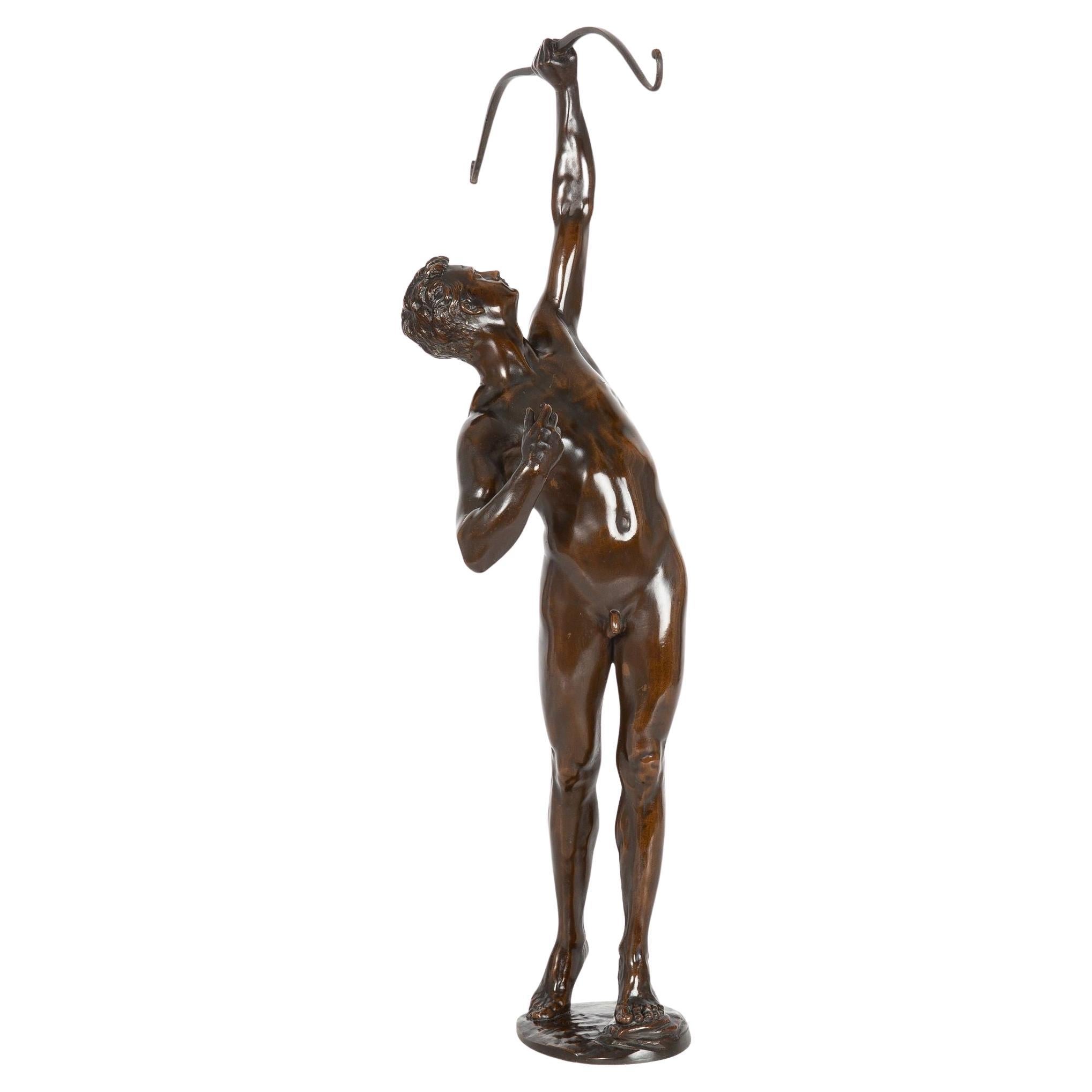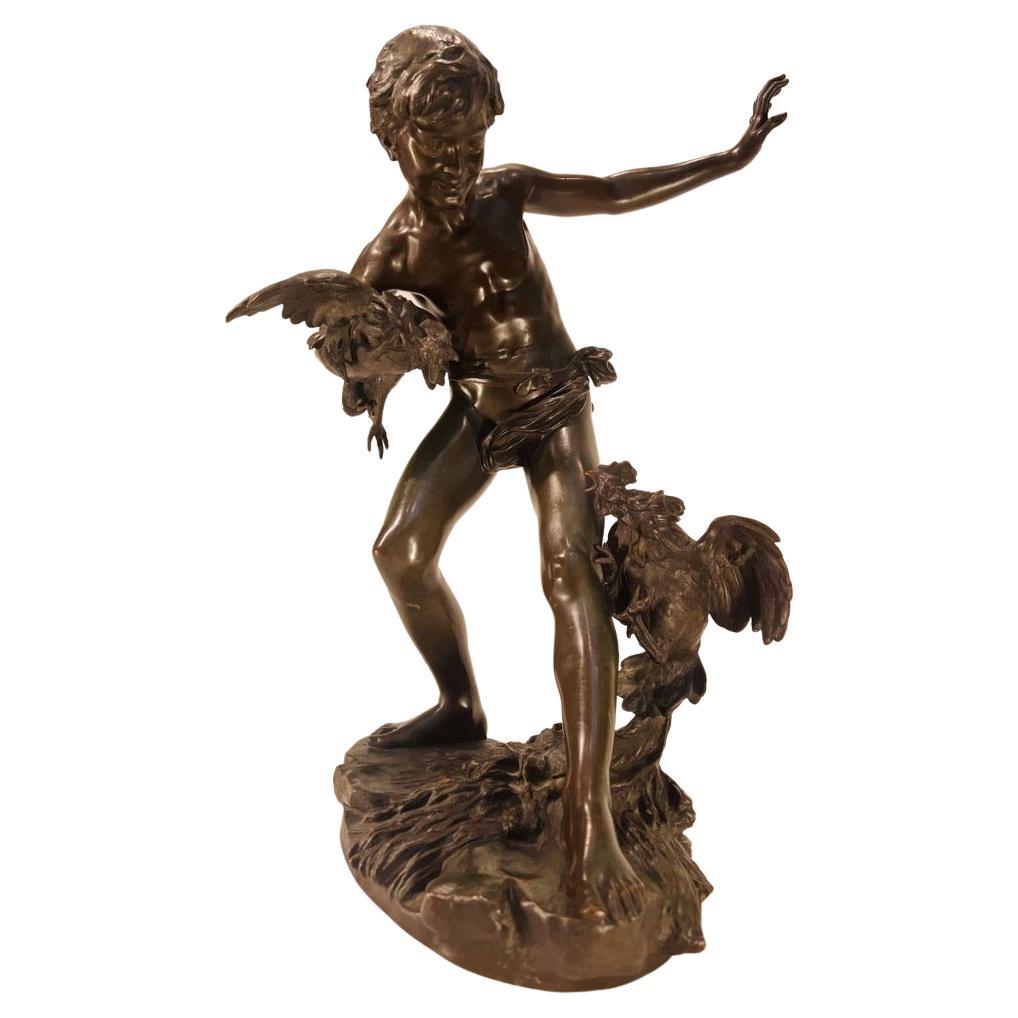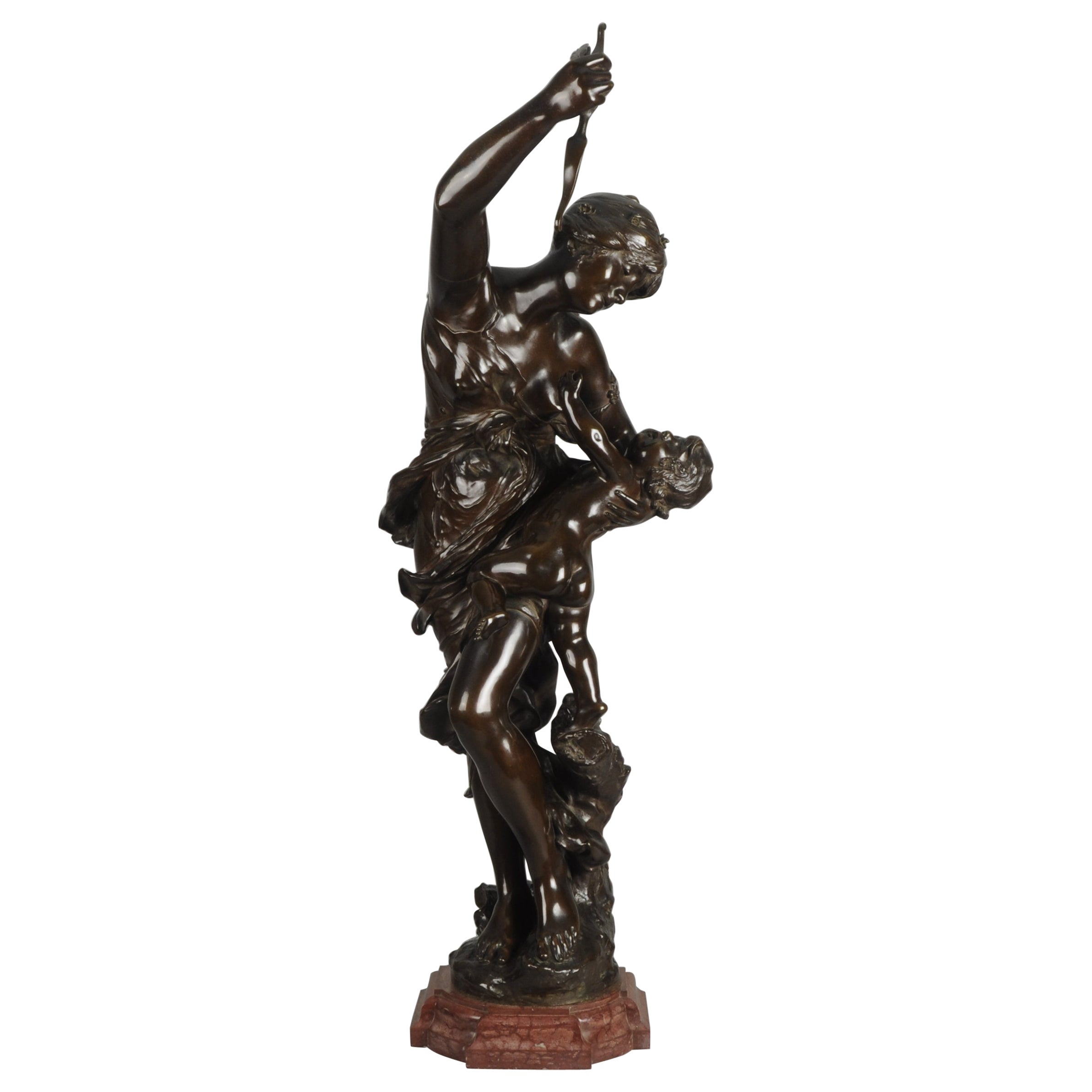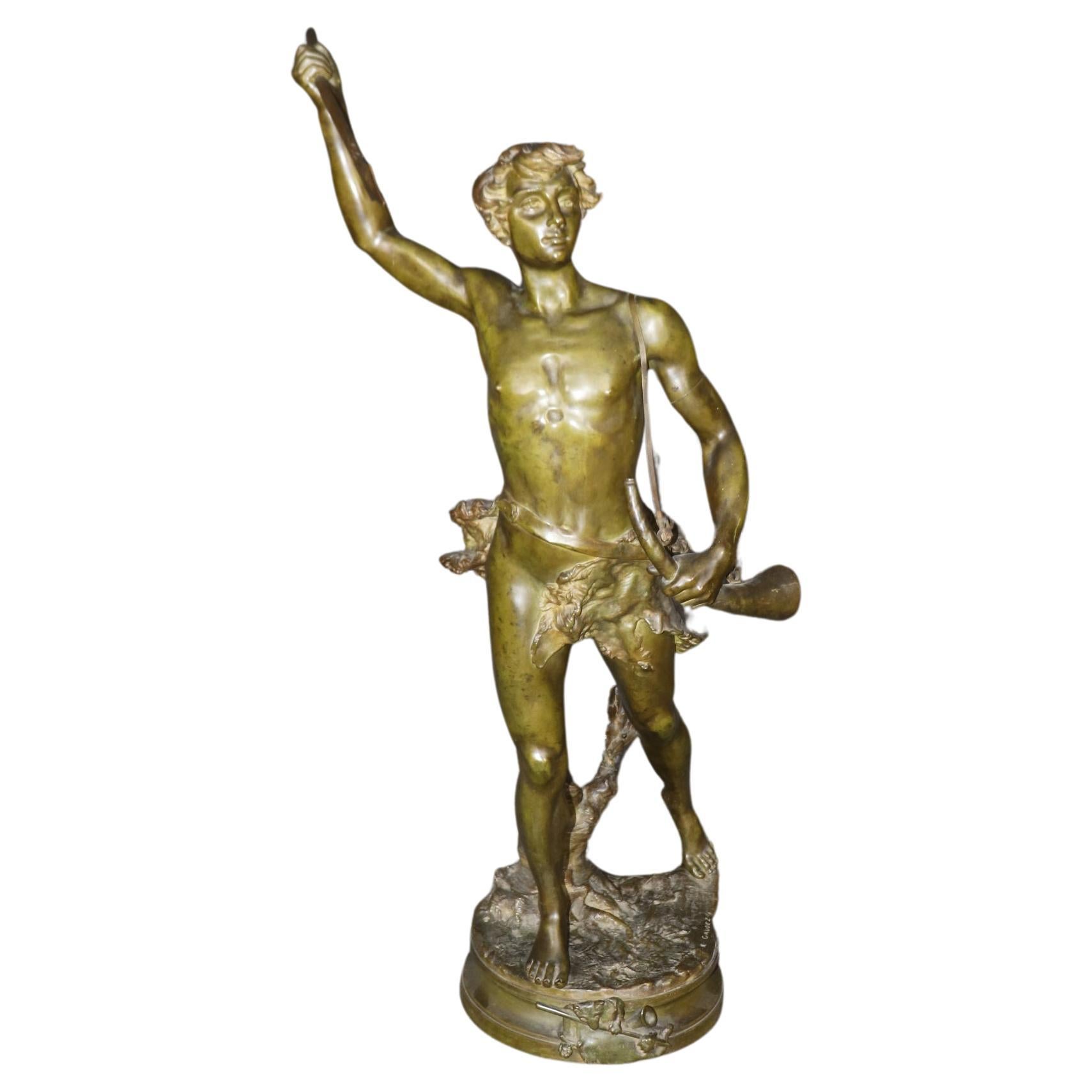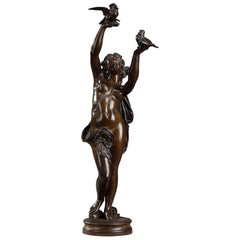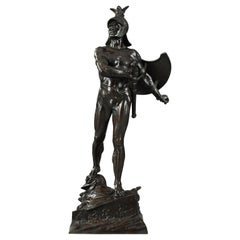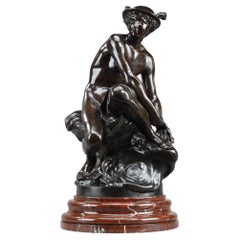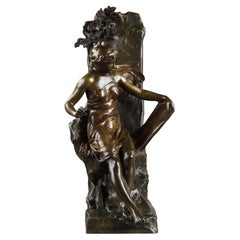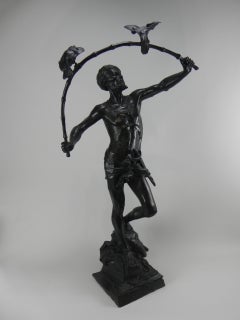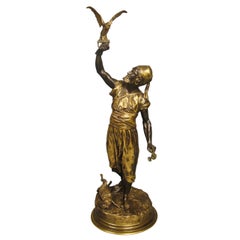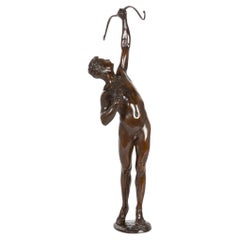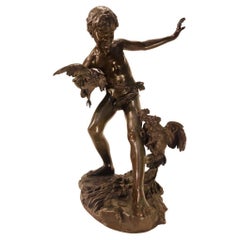Items Similar to Bronze Hindu Bird-Catcher by Auguste de Wever 'Belgian, 1836-1910'
Video Loading
Want more images or videos?
Request additional images or videos from the seller
1 of 22
Bronze Hindu Bird-Catcher by Auguste de Wever 'Belgian, 1836-1910'
$6,924.58
£5,106.81
€5,800
CA$9,570.81
A$10,643.38
CHF 5,585.32
MX$129,790.84
NOK 70,600.37
SEK 66,190.66
DKK 44,156.31
About the Item
Large bronze statue featuring a Hindu bird-catcher by the Belgian sculptor and medallist Auguste de Wever. He wears a ribbon and a drapery supporting a small sword. His necklace is adorned with an elephant-shaped medallion. Our bird-catcher testifies to the taste of the time for the exoticism and the fascination for the countries of the East and Far East. Antique edition cast in darkened patinated bronze. Signed de Wever on plinth and titled L'oiseleur Indou (Hindu bird-catcher).
circa 1900
Dimensions: W 13.8 in - D 11.8in - H 34.3in.
Dimensions: L 35cm, P 30cm, H 87cm.
- Creator:Auguste de Wever (Sculptor)
- Dimensions:Height: 34.26 in (87 cm)Width: 13.78 in (35 cm)Depth: 11.82 in (30 cm)
- Style:Art Nouveau (Of the Period)
- Materials and Techniques:Bronze,Patinated
- Place of Origin:
- Period:
- Date of Manufacture:1900
- Condition:Wear consistent with age and use. Overall, the bronze is in very good condition, with a very small crack on the bow.
- Seller Location:Paris, FR
- Reference Number:Seller: 26451stDibs: LU2065345679192
About the Seller
4.9
Gold Seller
Premium sellers maintaining a 4.3+ rating and 24-hour response times
Established in 2001
1stDibs seller since 2016
324 sales on 1stDibs
Typical response time: 2 hours
- ShippingRetrieving quote...Shipping from: Montesson, France
- Return Policy
Authenticity Guarantee
In the unlikely event there’s an issue with an item’s authenticity, contact us within 1 year for a full refund. DetailsMoney-Back Guarantee
If your item is not as described, is damaged in transit, or does not arrive, contact us within 7 days for a full refund. Details24-Hour Cancellation
You have a 24-hour grace period in which to reconsider your purchase, with no questions asked.Vetted Professional Sellers
Our world-class sellers must adhere to strict standards for service and quality, maintaining the integrity of our listings.Price-Match Guarantee
If you find that a seller listed the same item for a lower price elsewhere, we’ll match it.Trusted Global Delivery
Our best-in-class carrier network provides specialized shipping options worldwide, including custom delivery.More From This Seller
View AllBronze Sculpture Femme Aux Colombes by Charles-Alphonse Gumery
Located in Paris, FR
Bronze sculpture with brown patina by Charles-Alphonse Gumery, featuring a smiling young woman with doves. This bronze statuette is signed: Gumery ROME. Charles Gumery most probably ...
Category
Antique 19th Century Italian Napoleon III Figurative Sculptures
Materials
Bronze
Late 19th Century Bronze Sculpture The Warrior by Auguste de Wever
By Auguste de Wever
Located in Paris, FR
Large patinated bronze figure of an Antiquity warrior. He is set on a base decorated with battle scenes, marked: Les Chasseurs Éclaireurs de Bruxelles à leur Lt Colonel O. Tahon 1870...
Category
Antique Late 19th Century Belgian Art Nouveau Figurative Sculptures
Materials
Bronze
Large bronze after Pigalle, "Mercure attachant ses talonnières", 19th century
By Jean-Baptiste Pigalle
Located in Paris, FR
Brown patina bronze sculpture depicting Mercury (Hermes), god of commerce, thieves and messenger of the gods, seated on a rock tying his winged heel-piece. He is wearing a petasus, a winged hat, and his caduceus is resting on the ground. This sculpture, based on a model by Jean-Baptiste Pigalle, shows a young god, naked and in motion. In a double-swivel position, he prepares to take off. The bronze, resting on a circular stepped base in griotte red marble, is signed on the terrace "Pigalle, 1745". The original of this sculpture was Pigalle's reception piece for the Académie Royale de Peinture et de Sculpture on July 30, 1744, which entered the Louvre between 1848 and 1850.
Jean-Baptiste Pigalle:
The sculptor of the Enlightenment A great French sculptor, Jean-Baptiste Pigalle was born in Paris in 1714. He worked on his art from an early age under the guidance of Robert Le Lorrain and later Jean-Baptiste Lemoyne. Convinced that his art was the meaning of his life, he returned to Italy in 1734 to perfect his technique. On his return, he began his "Mercure attachant sa talonnière" (1740), which enabled him to enter the Beaux-Arts. His reputation soared among the Parisian aristocracy. Mme de Pompadour took him under her wing, and commissions poured in. Juggling between the Baroque and the Classical, he painted portraits of Diderot and Voltaire, then created the famous funeral monuments...
Category
Antique Mid-19th Century French Neoclassical Figurative Sculptures
Materials
Griotte Marble, Bronze
Sculpture "Memoria" in Patinated Bronze, Signed Emile Louis Picault
By Émile Louis Picault
Located in Paris, FR
Figure "Memoria" in bronze with brown and green shaded patina signed Emile Louis Picault. It represents a young woman seated, dressed in a drapery,...
Category
Antique 1890s French Figurative Sculptures
Materials
Bronze
19th Century Bronze Group After Falconet
By Étienne Maurice Falconet
Located in Paris, FR
Bronze group with brown patina featuring Cupids fighting over a heart after Etienne-Maurice Falconet (1716-1791). This work had a great success in the second half of the 19th century...
Category
Antique 19th Century French Louis XVI Figurative Sculptures
Materials
Marble, Bronze
Bronze sculpture "La Renommée", Signed Julien Causse
By Julien Causse
Located in Paris, FR
Sculpture depicting "La Renommée" in bronze with brown patina by Julien Causse. This young woman draped, bare shoulders, blows in a reed-shaped horn. She seems to be rising from a ro...
Category
Antique 1890s French Figurative Sculptures
Materials
Bronze
You May Also Like
Auguste DE WEVER (1836-1910) Hindu Birdcatcher
Located in Gent, VOV
Hindu Birdcatcher
A fine quality, a nineteenth-century bronze cast of the Hindu bird-catcher standing on an elephant skull and holding two birds in the air which are sitting on a bambu stick by Auguste De Wever (Belgian 1836-1910). Old cast probably by the Compagnie des Bronzes foundry signed...
Category
19th Century Figurative Sculptures
Materials
Bronze
French 19th Century Bronze Sculpture "The Falconer" by Pierre Jules Mene
By Pierre Jules Mêne
Located in London, GB
"The Arab Falconer" by Pierre Jules Mene
The finely cast and planished bronze, depicting a falconer walking on a naturalistic ground, with a hare ...
Category
Antique 19th Century French Sculptures
Materials
Bronze
German Bronze Sculpture of “Hercules & Stymphalian Birds” by Joseph Uphues
By Gladenbeck Foundry
Located in Shippensburg, PA
A fluid and sinuous depiction of Hercules the moment after releasing an arrow from his bow to kill the Stymphalian birds, it was one of Joseph Uphues'...
Category
20th Century German Figurative Sculptures
Materials
Bronze
Paul-Romain Chevré bronze 19th.
Located in Rio De Janeiro, RJ
Incredible french bronze "Separating the Cocks" in bronze.
Category
Antique Early 1900s French Rococo Figurative Sculptures
Materials
Bronze
19th Century Art Nouveau Bronze Entitled "Venus & Cupid" by Jean Sul-Abadie
By Jean Abadie
Located in London, GB
A very fine bronze study of Venus taking an arrow from Cupid her son, who at times would shoot his arrows without meaning or reason into the hearts of men, igniting their desire. Exhibiting excellent rich brown patina and good detail, signed Sul Abadie and stamped.
Additional information
Height: 93 cm
Condition: excellent condition
Circa: 1885
Materials: bronze & marble
SKU: 4979
ABOUT
Jean Sul-Abadie
Jean Sul-Abadie (Born 1850 ~ Died 15th April 1890) was a French artist, a pupil of Jouffroy and Falguière. Specialising in bronze sculpting in the Art Nouveau style. He made his Salon debut in 1872.
Cupid & Venus
Different tales exist about the origin of Venus and Cupid. Some say that Venus, the goddess of love and beauty, had a love affair with Mars, the god of war. Out of this relationship, Cupid was born. In the following painting you see Venus with Mars, who is being disarmed by Cupid.
Cupid has attributes from both of his parents. Like his mother he is considered to be the god of love, or more precisely, the god of falling in love. He is portrayed as an innocent little child with bow and arrows. He shoots arrows to the heart, and awakening a love that you’re powerless to resist.
In classical mythology, Cupid (Latin Cupido, meaning “desire”) is the god of desire, erotic love, attraction and affection. He is often portrayed as the son of the love goddess Venus and the war god Mars, and is known in Latin also as Amor (“Love”). His Greek counterpart is Eros.
Although Eros is in Classical Greek art as a slender winged youth, during the Hellenistic period, he was increasingly portrayed as a chubby boy. During this time, his iconography acquired the bow and arrow that represent his source of power: a person, or even a deity, who is shot by Cupid’s arrow is filled with uncontrollable desire. In myths, Cupid is a minor character who serves mostly to set the plot in motion. He is a main character only in the tale of Cupid and Psyche, when wounded by his own weapons he experiences the ordeal of love. Although other extended stories are not told about him, his tradition is rich in poetic themes and visual scenarios, such as “Love conquers all” and the retaliatory punishment or torture of Cupid.
In art, Cupid often appears in multiples as the Amores, or amoriniin the later terminology of art history, the equivalent of the Greek erotes. Cupids are a frequent motif of both Roman art and later Western art of the classical tradition. In the 15th century, the iconography of Cupid starts to become indistinguishable from the putto.
Cupid continued to be a popular figure in the Middle Ages, when under Christian influence he often had a dual nature as Heavenly and Earthly love. In the Renaissance, a renewed interest in classical philosophy endowed him with complex allegorical meanings. In contemporary popular culture, Cupid is shown drawing his bow to inspire romantic love, often as an icon of Valentine’s Day.
Venus is the Roman goddess whose functions encompassed love, beauty, sex, fertility, prosperity, victory, and desire. In Roman mythology, she was the mother of the Roman people through her son, Aeneas, who survived the fall of Troy...
Category
Antique Late 19th Century French Art Nouveau Figurative Sculptures
Materials
Breccia Marble, Bronze
Adrien Étienne Gaudez Figural Bronze Sculpture 'Acteon" Man Hunting with Spear
By Adrien Étienne Gaudez
Located in Swedesboro, NJ
This is a superb, attributed Adrien Gaudez sculpture titled " Acteon" which in Greek is
Actaeon the mythical Theban hero showing him poised to throw a spear at prey. The definition ...
Category
Vintage 1920s French Art Nouveau Figurative Sculptures
Materials
Bronze
$3,596 Sale Price
20% Off
More Ways To Browse
Hindu Furniture
Antique Bird Necklace
Antique Hindu Sculpture
Gold Elephant Necklace
Hindu Statues
Sword Necklace
Large Bird Statue
Bronze Elephant Statue
Antique Elephant Statues
Hindu Bronze Statue
French Drapery Necklaces
Carved Medusa
Cobalt Blue Figurines
Hermes Statue
Josef Lorenzl Bronze
Macassar Ebony Sculptures
Mercury Marble Sculpture
Milwaukee Chair Company
